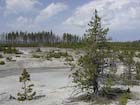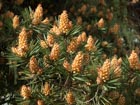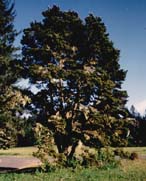
Trees growing in a peat bog on the Olympic Peninsula in Washington. P. contorta subsp. contorta is commonly found in bogs throughout its range [C.J. Earle, 1999.04].

Tree of subsp. murrayana on summit of Sonora Pass, California [C.J. Earle, 2008.06.29].

P. contorta in general enjoys a competitive advantage on harsh sites. These trees of subsp. latifolia are growing in the Norris Geyser Basin at Yellowstone Natl. Park [C.J. Earle, 2007.07.22].

Active pollen cones of a specimen of subspecies contorta growing native at Cape Disappointment State Park, Washington [C. J. Earle, 2013.05.11].

A typical seedling; this is of subsp. latifolia growing near Mt. Adams, Washington [C.J. Earle, 2017.05.29].

A specimen of subspecies contorta growing native at Patrick's Point, California [C.J. Earle, 1999.05].

Two 3-5 m tall trees of subspecies contorta growing as ornamentals within their native range in Seattle (USA) [C.J. Earle, 1999.03.19].

P. contorta subsp. latifolia is among the most fire-adapted pines. This shows a burn mosaic above Mammoth, Wyoming, 1 year post-fire [C.J. Earle, 1989.07.02].

This shows the same site, 30 years post-fire. Areas with the most severe burn (black in the 1989 photo) have sparse regeneration; areas with less severe burn (brown in 1989 photo) show a closed-canopy forest of lodgepole pine regeneration [C.J. Earle, 2018.05.28].

Album of photographs of plants in habitat, at iNaturalist.

Although P. contorta is not generally thought of as a subject for fine woodworking, it is the preferred species for log cabins. The most noteworthy example is the Old Faithful Inn, built in 1904 in Yellowstone National Park; the lobby is shown here. Originally the entire building was constructed of P. contorta with Pseudotsuga menziesii flooring; the main lobby floor has since been replaced with the more durable Acer saccharum seen here [C.J. Earle, 2018.05.31].


Conservation Status

Pinus contorta
Douglas ex Loudon (1838)
Common names
Lodgepole pine.
Taxonomic notes
Three subspecies and two varieties:
- Pinus contorta subsp. contorta. Further information on the subsp. contorta page.
- Pinus contorta subsp. contorta var. bolanderi (Parl.) Vasey. Further information on the subsp. contorta page.
- Pinus contorta subsp. latifolia (Engelm.) Critchf. Further information on the subsp. latifolia page.
- Pinus contorta subsp. murrayana (Balfour) Engelmann. Further information on the subsp. murrayana page.
- Pinus contorta var. yukonensis W.L.Strong (2010). Type: 60.6581°N, 135.225°W, ~10 km southwest of downtown Whitehorese, Yukon, Canada, west slope of Mount McIntyre, elevation 1280 m, 2009.10.14, Wayne L. Strong s.n. (isotype CAN 588198). No synonyms.
These taxa are sometimes all treated at the rank of variety (e.g., Kral 1993), but researchers actively involved with study of the species normally recognise them at subspecific rank, observing the substantial genetic and adaptational differences between them (Critchfield 1957; Wheeler and Guries 1982a, 1982b; Wheeler and Critchfield 1985; von Rudloff and Lapp 1987; Aitken and Libby 1994). It appears that molecular studies will be needed to ascertain the relationships of var. yukonensis, but Strong (2010) sees it as closer to subsp. contorta than to subsp. latifolia. The validity of var. bolanderi is debatable; its only consistent morphological difference from subsp. contorta is in the number of resin canals. However, it is a distinctive ecotype and researchers studying it typically assign it a taxonomic rank.
P. contorta is the type species of Pinus subsection Contortae, a clearly-defined group of hard pines endemic to North America and including 5 species of short-needled, small-coned, prolific pines that are effective competitors on very poor soils and that generally are well adapted to rapid regeneration after stand-destroying fire.
Description
Shrubs or trees to 50 m tall and 90 cm dbh, straight to contorted, with crown varying according to genetic race; lower branches often descending, the upper spreading or ascending. Bark brown to gray- or red-brown, platy to furrowed, variable in thickness both between and within populations. Twigs slender, multinodal, rough, orange to red-brown, aging darker brown. Leaves yellow-green to dark green, 2 (rarely 3) per fascicle, spreading or ascending, persisting 3-8 years, 2-8 cm × 0.7-2(-3) mm, twisted, all surfaces with fine stomatal lines, margins finely serrulate, apex blunt to acute or narrowly acuminate; sheath 3-6(-10) mm, persistent. Buds narrowly to broadly ovoid, dark red-brown, to 12 mm, slightly resinous. Pollen cones densely whorled at base of current-year shoot, ellipsoid to cylindric, 5-15 mm long, orange-red, yellow when fertile. Seed cones variably asymmetric, lanceoloid to ovoid before opening, broadly ovoid to globose when open, (2-)3-6(-7.5) cm long, tan to pale red-brown, lustrous, nearly sessile or on a peduncle to 2-3 mm long, maturing in 16-20 months, variably serotinous, variably persistent. Cone scales with nearly rhombic apophyses, variously elongate, cross-keeled, often mammillate toward outer cone base and on inside above middle; umbo central, depressed-triangular, prickle barely elongate to stubby or slender and to 6 mm. Seeds compressed, obovoid; body ca. 5 mm, black (infertile seeds often mottled pale to red-brown), wing 10-14 mm. 2n=24 (Critchfield 1957, Kral 1993). See García Esteban et al. (2004) for a detailed characterization of the wood anatomy.
The subspecies of Pinus contorta can identified according to the key shown below (from Kral 1993). Trees near the boundaries between subspecies will often show intermediate traits.
1. |
Leaves 2-7 cm × 0.7-0.9(-1.1) mm, dark green; mature trunk with bark evidently furrowed; seed cones strongly asymmetric, strongly recurved, persistent or variously serotinous. |
subsp. contorta |
+ |
Leaves (4-)5-8 cm × (0.7-)1-2(-3) mm, yellow-green; mature trunk with bark not evidently furrowed; seed cones asymmetric to nearly symmetric, recurved to spreading, variously serotinous or soon shed. |
2 |
2. |
Seed cones asymmetric, recurved, variously serotinous, long-persistent; mid and lower apophyses mostly much domed; main branches mostly horizontally spreading, not ascending at tip. |
subsp. latifolia |
+ |
Seed cones nearly symmetric, mostly spreading, not serotinous, not persistent; mid and lower apophyses mostly shallowly domed; main branches ascending at tips. |
subsp. murrayana |
A description of var. yukonensis is not available, but POWO (2025) reports that its growth habit is always a shrub, and it has a very limited distribution.
Kral (1993) states that Pinus contorta can be distinguished from its near relative P. banksiana by its seed cones, which are curved forward on branches, unarmed or with small reflexed apiculi. In P. banksiana the seed cones are spreading to recurved on branches, mostly armed with prickles. Farjon (2010) distinguishes the two species by pollen cone color (orange-red before anthesis is P. contorta vs. yellow in P. banksiana) and by details of the mature seed cone. In P. contorta it is ovoid, asymmetrical at base when closed, and the umbos bear a variable but persistent prickle. In P. banksiana the seed cones are asymmetrical, curved when closed, and serotinous, with unarmed umbos. Note that cones of subsp. latifolia are also generally serotinous; also, in my experience, the closed cones of P. banksiana have a greater length/width ratio than those of P. contorta.
Distribution and Ecology
W USA, W Canada, Mexico: Baja California Norte, at 0-3500 (-3900) m (Critchfield 1957, Wheeler and Guries 1982). Hardy to Zone 7 (cold hardiness limit between -17.7°C and -12.2°C) (Bannister and Neuner 2001) (I suspect this refers to subsp. contorta). See also Thompson et al. (1999). See the various subspecies descriptions for particulars.
Var. yukonensis is only reported from a small area in Yukon, Canada, bounded by latitude 59.8-60.9°N and longitude 133.1-136.3°W (GBIF 2025). Based on published photos, its habitat appears to be tundra.
Distribution of P. banksiana (blue) and P. contorta (color coded by subspecies and variety), based on data downloaded from GBIF: 2021.02.27, DOI: https://doi.org/10.15468/dl.yszq86 (banksiana) and 2021.02.27, DOI: https://doi.org/10.15468/dl.au4a94 (contorta) and 2025.02.07, DOI: https://doi.org/10.15468/dl.3yqdgt (var. yukonensis). The boundaries are gradational; for instance, subsp. latifolia is found on fire-prone sites within the mapped distribution of subsp. contorta, e.g. at Deer Park in the northeastern Olympic Mountains; subsp. contorta occurs at some fire-resistant sites (such as bogs) east of the Cascade crest; and the boundary between these and subsp. murrayana is gradational.
"Pinus contorta is fire successional over most of its range and is characterized by prolific seeding and high seed viability in disturbed habitats, often resulting in extremely slow-growing, overly dense stands" (Kral 1993). See the subspecies descriptions for more detailed information.
Pinus contorta has become naturalised in some areas including New Zealand, and more locally in Britain; in New Zealand this has become a serious problem adversely affecting native vegetation (papers in Richardson 1998).
Remarkable Specimens
Generally, the largest individuals are found in subsp. murrayana, followed by subsp. contorta and then subsp. latifolia. Some trees of var. bolanderi are of "normal" size, but when growing on adverse soils this is the smallest pine and one of the smallest of all conifers, with sexually mature individuals as short as 20 cm recorded.
The oldest known trees are all in subsp. murrayana.
Ethnobotany
See the various subspecies descriptions. Lodgepole pine (subspecies not specified, but I suspect latifolia) is one of the most widely planted timber trees in Iceland (Icelandic Forest Service 2017).
Observations
See the various subspecies descriptions.
Remarks
P. contorta and P. banksianashow some striking similarities to species of the P. mugo complex in Europe, including extensive occurrence at and near the alpine treeline, growth on strongly nutrient-limited sites, adaptation to highly acid wetland soils including peat bogs, short needles combined with small cones and seeds, and a shrub or small tree growth form. Since their evolutionary tracks diverged at the start of the Eocene with the divergence of Sections Pinus and Trifoliae (Jin et al. 2021), these commonalities must represent convergent evolution.
Although contradictory, both the Latin and common names accurately describe the species: members of subsp. contorta, first observed growing near the Pacific Ocean (where David Douglas collected and described the species), are intricately contorted by the effects of wind and salt spray; while trees of subsp. latifolia, the commonest tree in Wyoming and much of the remainder of the Rocky Mountains, grow tall and slender, making them ideal material for the lodge-poles of Plains Indian tipis.
Citations
Aitken, S.N. and W.J. Libby. 1994. Evolution of the pygmy-forest edaphic subspecies of Pinus contorta across an ecological staircase. Evolution 48: 1009-1019.
Critchfield, W.B. 1957. Geographic variation in Pinus contorta. Maria Moors Cabot Foundation (Harvard) Publ. 3.
Icelandic Forest Service. 2017. Forestry in a treeless land. http://www.skogur.is/english/forestry-in-a-treeless-land, accessed 2017.11.01, now defunct.
Jin, Wei-Tao, David S. Gernandt, Christian Wehenkel, Xiao-Mei Xia, Xiao-Xin Wei, and Xiao-Quan Wang. 2021. Phylogenomic and ecological analyses reveal the spatiotemporal evolution of global pines. Proceedings of the National Academy of Sciences 118(20):e2022302118. doi.org/10.1073/pnas.2022302118.
Loudon, J.C. 1838. Arboretum et Fruticetum Britannicum 4: 2292, figs. 2210, 2211.
Rweyongeza, D.M., Dhir, N.K., Barnhardt, L.K., Hansen, C. and Yang, R.C. 2007. Population differentiation of the lodgepole pine (Pinus contorta) and jack pine (Pinus banksiana) complex in Alberta: growth, survival, and responses to climate. Canadian Journal of Botany 85(6):545-556.
Strong, W. L. 2010. Pinus contorta var. yukonensis var. nov. (Pinaceae) from south–central Yukon, Canada. Nordic Journal of Botany 28(4). doi.org/10.1111/j.1756-1051.2010.00824.x.
von Rudloff, E. and M.S. Lapp. 1987. Chemosystematic studies in the genus Pinus. VI. General survey of the leaf oil terpene composition of lodgepole pine. Canadian Journal of Forest Research 17: 1013-1025.
Wheeler, N.C. and W.B. Critchfield. 1985. The distribution and botanical characteristics of lodgepole pine: biogeographical and management implications. Pp. 1-13 in D.M. Baumgartner (ed.). Lodgepole pine: the species and its management. Pullman, WA: Washington State University.
Wheeler, N.C. and R.P. Guries. 1982a. Population structure, genic diversity, and morphological variation in Pinus contorta Dougl. Canadian Journal of Forest Research 12: 595-606.
Wheeler, N.C. and R.P. Guries. 1982b. Biogeography of lodgepole pine. Canadian Journal of Botany 60: 1805-1814.
Wood, Lisa. 2006. An investigation of natural hybridization between jack pine (Pinus banksiana) and lodgepole pine (Pinus contorta var. latifolia) in northern British Columbia. M.S. Thesis, University of Northern British Columbia.
See also
Elwes and Henry 1906-1913 at the Biodiversity Heritage Library. This series of volumes, privately printed, provides some of the most engaging descriptions of conifers ever published. Although they only treat species cultivated in the U.K. and Ireland, and the taxonomy is a bit dated, still these accounts are thorough, treating such topics as species description, range, varieties, exceptionally old or tall specimens, remarkable trees, and cultivation. Despite being over a century old, they are generally accurate, and are illustrated with some remarkable photographs and lithographs.
FEIS database.
Lanner (1983).
Mirov, N. T. 1954. Lodgepole pine discovered and misnamed. Madroño 12:156-157. Available: Biodiversity Heritage Library, accessed 2021.12.19.












